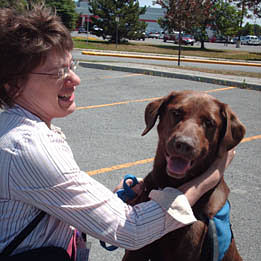
My name is Erin. I am a 41-year-old woman with cerebral palsy. I have
two brothers and as I grew up, my parents always considered me no more
and no less than “one of three children.”
That meant no special treatment. At school, I was fully integrated
from the very beginning, because it never occurred to my mother that
it should be any different; she enrolled me in kindergarten and
mentioned my disability as an afterthought. I skied because my
brothers skied. I had the time of my life at a family camping spot
that was anything but accessible to wheelchairs (My dad put up some
hand-fashioned parallel bars in the middle of nowhere so I could keep
up with my exercises). I learned to drive the lawnmower. I had my
share of “dish nights,” no matter how much I hated drying cutlery.
Every house the family lived in had stairs that I crawled up and slid
down. And I was expected to land my own fish, muscle spasms, poor
balance, and fearful, excited pleas notwithstanding.
Talk about drawing a winning lottery ticket.
These days, I live alone in a downtown Ottawa condo, work full time,
and still love my family to distraction. It remains important to me to
live as much as possible as an independent part of the mainstream.
But the hard truth is that as I get older, keeping myself out of pain
and maintaining my range of motion, thereby my level of independence,
has become a greater challenge than ever before. Regular physical
therapy appointments help me to manage spasticity-induced back pain
and I’m having difficulty with my floor-to-chair, chair-to-chair,
chair-to-bed, and chair-to-toilet transfers.
My physical challenges have been compounded over the last five years
by the early onset of osteoporosis as well as repeated struggles with
depression and anxiety. These periods of darkness, besides being
unspeakably frightening for both me and my family, wreak havoc on my
spasticity and set back my physical health exponentially. I must do
everything I can to reduce the chances of another depressive episode
or at least to have a mitigation plan in place should I find myself in
a dark place again. Medication is part of the plan, of course, but it
only goes so far.
It is my hope that a service dog, trained to help me with mobility
challenges, will also be a steady presence that I can focus on to keep
myself grounded when I feel out of control and when I am most lonely
and afraid.
I applied for a service dog once before through another organization
and was approved. Unfortunately, Maya, the dog I was working with, had
to be removed from the program before we graduated. I was heartbroken
and discouraged. And then, this year, I found the hard-working,
big-hearted organization that is Kingston 4 Paws. In the staff, I
found incredibly supportive people, with can-do attitudes, who gave me
the confidence to submit a service dog application and believe that,
this time, I would bring a canine partner home.
Thank you for believing with me and helping me to reach my
fund-raising goal to make this happen.
